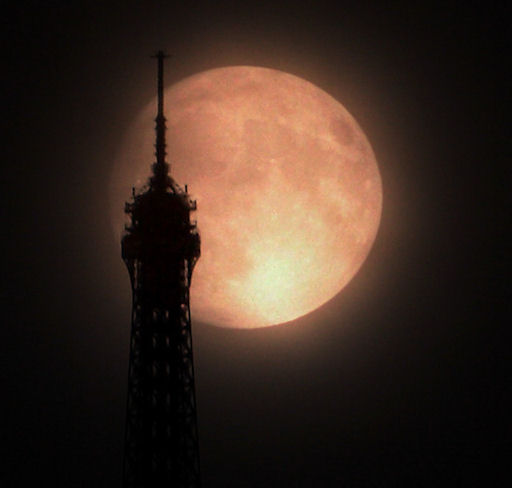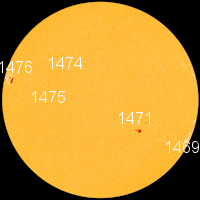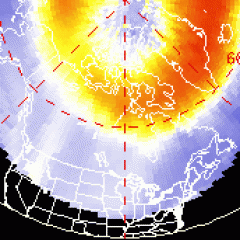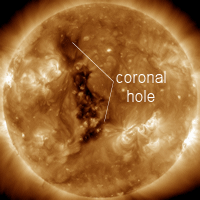~Space Weather Update~ Big New Sunspot Coming Around~ [1]
BIG NEW SUNSPOT: New sunspot 1476 is large and crackling with impulsive M-class [2] solar flares. Because of the active region's location near the east limb, the eruptions are not geoeffective, although this could change in the days ahead as the sunspot turns toward Earth. Solar flare alerts: text [3], phone [4].
LIVE METEOR RADAR: NASA's all-sky fireball network [5] captured another haul of bright eta Aquarid meteors [6] last night--ten fireballs in all. This suggests that the shower is still active, and might even be peaking, on May 6th. Tune into Space Weather Radio [7] for live echoes from these bits of Halley's Comet as they fly over the US Air Force Space Surveilance Radar in Texas.
SUPER MOON: Last night's full Moon was a "super moon," as much as 14% bigger and 30% brighter than other full moons of 2012. The phenomenon, also known as a perigee moon [8], is caused by the elliptical shape of the Moon's orbit around Earth. Big, nearby moons like this come along about once a year; they are harmless, beautiful, and, seen from certain angles, very romantic:
VegaStar Carpentier of Paris, France, took the picture on May 5th.
The moonlight was so intense in Veszprem, Hungary, "the birds started singing because they thought it was morning," reports Monika Landy-Gyebnar. "I went out at 2 AM in almost daylight conditions. The landscape was visible in full color [10], the sky was vivid blue and only the brightest stars were visible. The perigee Moon lit the world with its full brightness."
more moonshots: from John Minnerath [11] of Crowheart, Wyoming; from Peter Rosén [12] of Stockholm, Sweden; from Kamila Mazurkiewicz [13] of Puławy, Poland; from Halldor Sigurdsson [14] of Reykjavik, Iceland; from Sima Doshmanfana [15] of Yazd, Iran; from P. Nikolakakos [16] of Sparta, Greece; from Veerayen Mohanadas [17] of Simpang Empat, Perak, Malaysia; from George Kourounis [18] of Norman, Oklahoma; from Frederic Hore [19] of Lachine, Quebec; from Jean-Sébastien Roux [20] of Montreal Canada; from Chris Farina [21] of Ann Arbor, Michigan; from Alan Conrad [22] of Liverpool, Nova Scotia; from Dean Verner [23] of Elmvale, Ontario; from David Marshall [24] of Christ Church, Barbados; from José Geraldo Mattos [25] of Santa Catarina, Brasil; from Gustavo Rojas [26] of São Carlos, Brasil

![]()
Solar wind
speed: 341.4 km/sec
density: 1.6 protons/cm3
explanation [27] | more data [28]
Updated: Today at 1636 UT
![]()
X-ray Solar Flares
6-hr max: C1 1142 UT May06
24-hr: M1 0118 UT May06
explanation [29] | more data [30]
Updated: Today at: 1600 UT
![]()
![]()
![]()
Daily Sun: 06 May 12
![]()
![]()
New sunspot 1476 is crackling with impulsive M-class [2] solar flares. Credit: SDO/HMI
![]()
![]()
![]()
Sunspot number: 88
What is the sunspot number? [32]
Updated 05 May 2012
Spotless Days
Current Stretch: 0 days
2012 total: 0 days (0%)
2011 total: 2 days (<1%)
2010 total: 51 days (14%)
2009 total: 260 days (71%)
Since 2004: 821 days
Typical Solar Min: 486 days
Updated 05 May 2012
The Radio Sun
10.7 cm flux: 114 sfu
explanation [33] | more data [34]
Updated 05 May 2012
![]()
![]()
![]()
Current Auroral Oval:
![]()
Switch to: Europe, USA, New Zealand, Antarctica
Credit: NOAA/POES
![]()
![]()
![]()
Planetary K-index
Now: Kp= 2 quiet
24-hr max: Kp= 2 quiet
explanation [36] | more data [37]
![]()
Interplanetary Mag. Field
Btotal: 7.6 nT
Bz: 3.3 nT north
explanation [38] | more data [39]
Updated: Today at 1635 UT
![]()
![]()
![]()
Coronal Holes: 06 May 12
![]()
![]()
Solar wind flowing from this coronal hole should reach Earth on May 9-10. Credit: SDO/AIA.



